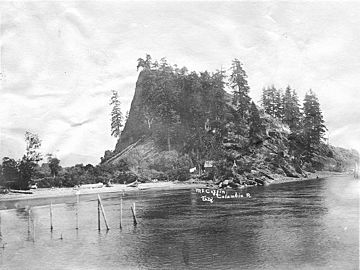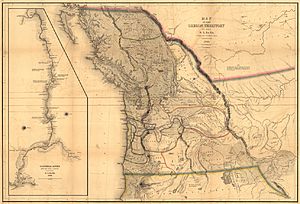Mount Coffin facts for kids
Quick facts for kids Mount Coffin |
|
|---|---|

Mount Coffin as it was in 1900
|
|
| Highest point | |
| Geography | |
| Location | Longview, Washington, U.S. |
| Topo map | USGS Kelso |
Mount Coffin was a special hill in what is now Longview, Cowlitz County, Washington, U.S.. It was an important burial ground for the Skillute tribe. This tribe, who spoke a language called Chinook Jargon, buried their dead above the ground.
Lieutenant William Robert Broughton named the burial ground "Mount Coffin" in 1792. He was part of George Vancouver's expedition on the ship HMS Chatham. The hill was later completely removed to get gravel for building the Port of Longview.
Contents
What Mount Coffin Looked Like
Mount Coffin was about 240 feet (73 meters) tall. It was made from dirt and rocks carried by the Columbia River and Cowlitz River. These materials gathered where the two rivers met. The hill was mostly made of basalt sediment, which is like volcanic ash.
Mount Coffin's History
Early Explorers and Native Traditions
In 1792, Lieutenant William Robert Broughton explored the lower Columbia River. He wrote about "a remarkable mount" where he saw several canoes. These canoes held dead bodies. Because of this, he named it Mount Coffin.
Another explorer, William Clark, saw the hill in November 1805. He called it a "very remarkable Knob" that rose from the water's edge. He said it was about 80 feet (24 meters) high and 200 paces around its base.
Clark also wrote about meeting the native people. They traded beaver skins, berries, salmon, and a plant called wappato. Meriwether Lewis noticed that the Skillute tribe spoke differently from tribes further inland. This was because the Skillute traded along the Pacific Coast, so their language had adopted words from coastal tribes.
In 1835, John Kirk Townsend visited Mount Coffin. He described the burial site: "It had many canoes with bodies of Native Americans. Each body was carefully wrapped in blankets. They also had their personal items like weapons and tools."
He explained that these tribes cared for their dead just like hunting tribes on the prairies. The dead were placed in their canoes with their paddles and fishing tools. These canoes were set on a rock or high place overlooking the river. This was so they could begin their journey in the next world.
Doctors were interested in the Skillute tribe's practice of head flattening for babies. In 1825, John Scouler wanted to study their skulls. Later, in 1847, a "curio hunter" took valuable items from a body on Coffin Rock.

Another event happened in 1841. Lieutenant Charles Wilkes visited Mount Coffin. He used the hill to study the stars. Sadly, one of Wilkes's campfires accidentally burned the burial canoes on the rock.
Many Native Americans in the area suffered from diseases like fever and malaria. A trader from the Hudson's Bay Company in Fort Vancouver, Washington, about 40 miles (64 km) from Mount Coffin, described these illnesses. They were often deadly.
The Industrial Age and Mount Coffin's End
In 1900, Friedrich Weyerhäuser bought a huge amount of land, about 900,000 acres (3,600 km2). He saw a lot of promise in the Northwestern United States and started his business there.
After World War I, Robert A. Long bought land near Mount Coffin from the Weyerhaeuser Timber Company. This land had a huge amount of timber. He later bought even more land. In 1922, studies showed that building a city at the mouth of the Cowlitz River would be a good idea. This area became the city of Longview, Washington. In June 1924, the Long–Bell lumber mill opened. It was the biggest lumber producer in the world.
Frederick Weyerhaeuser also opened a mill next to the Long-Bell Lumber Company's operation. This mill was very close to Mount Coffin. Soon after, in 1929, Mount Coffin was blasted with dynamite and used for its gravel. After cutting billions of board feet of lumber, Long's two big sawmills were taken apart in 1960.
The old Long-Bell Mill buildings are still there, though they are no longer used. They are very large, about 600 feet (180 meters) long. They were built with huge timbers from the original forests of western Washington. Buildings like these will likely never be built again.
Weyerhaeuser continued to make paper and other wood products. In 1964, a lawsuit was filed against Weyerhaeuser in Longview. It was for "discharging waste into rivers." In 1979, the Government Accountability Office listed the Weyerhaeuser Company in Longview as a possible Superfund site. This meant it had serious metal contamination.
Since then, Weyerhaeuser Company has found new ways to reduce pollution. They use special equipment called clarifiers. They also burn organic waste like wood chips and paper sludge to create steam and electricity.

